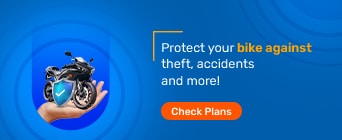Subtext- Learn what, why, where, and how of driving licence tests in India. Prepare for the test with sample driving licence test questions.
A driving licence is an official document that permits you to drive your motor vehicle on public roads. As per Motor Vehicles Act, 1988, it's important to have a driving licence to showcase you have necessary skills and knowledge to drive safely. This document is also accepted as an identification proof in India.
To get a driving licence, the process starts with first applying for a learners licence. You can apply for a permanent driving licence after 30 days of getting a learners licence. The learning licence is valid for 6 months, within which you should apply for the permanent one.
To get a learners licence, you need to get through a mandatory driving licence test conducted by the Road Transport Authority (RTO).
To take the driving licence test, apply for a learners licence through the Parivahan Sewa website. Here are the detailed steps you need to follow:
Click on the website https://parivahan.gov.in
Select "Online Services" tab and select "Driving Licence Related Services”
You will be directed to the https://sarathi.parivahan.gov.in/sarathiservice/stateSelection.do page
Select your state from the dropdown menu
Click on "Apply Online" and select "New Driving Licence”
Fill out the application form with the required details and submit it
You will be prompted to book a time slot for the mandatory driving test
Select a convenient date and time for your test
- If you don't get automatically prompted for the test, you can visit the https://sarathi.parivahan.gov.in/sarathiservice/stateSelection.do site again and select “Online LLTest(STALL)”
According to RTO rules, you can apply for a driving licence if you are above the age of 16 for driving a vehicle without gears, whose engine does not cross the capacity of 50 cc or above 18 years of age for other private vehicles.
The driving licence test questions are based on the traffic rules and regulations you need to abide by. They assess your knowledge of traffic rules and your ability to take responsible driving decisions. The driving licence test typically involves both a written test and a practical driving test.The questions are in the Multiple Choice Question (MCQ) format with 3/4 available options. A total of 15 learning licence test questions are asked in the exam and you must correctly answer 9 questions. You will have 30 seconds to choose the right option for each question.
If you pass the test, your Driving Licence will usually be dispatched within 2 weeks. You can check its status online by following the same steps as above, under "Application Status".
On successfully completing the learning licence test, you can practice your driving skills to apply for a permanent licence.
To take the learner's licence test for the first time, you need to pay ₹50. If you fail the test and want to take it again, you have to pay ₹50 again. Once you clear the written test, you can pay another ₹300 to take the driving test when applying for the permanent licence . This fee is for each class of vehicle you want to be licensed to drive. For example, if you want to be licensed to drive both a car and a motorcycle, you need to pay ₹300 for each class, so a total of ₹600.
In order to prepare for the driving licence test you can practice solving the sample questions. You can practice sample questions from the official Sarathi Parivahan site by following these steps:
Visit: https://sarathi.parivahan.gov.in/sarathiservice/sarathiHomePublic.do#
Click on “Tutorial for LL Test”
Fill Application number and captcha code
Select “Generate OTP”
Once you view the complete video, the system will ask the confirmation to submit. Once submitted, you can proceed to the LL test
Here are some sample RTO exam questions to give you an idea about the type of driving licence test questions. The right answer for each question is highlighted in bold.
Q1. On a one-way road, you should not
Overtake
Drive in reverse gear
Park
Q2. When you see a traffic sign of a school nearby, you should
Honk and keep going at the same speed
Reduce your speed and drive with care
Stop the vehicle
Q3. You can distinguish transport vehicles through their
Number plate
Colour
Size of the tyre
Q4. How old do you need to be to drive a gearless two-wheeler?
18 years
16 years
21 years
Q5. In case there is no footpath, the pedestrians will walk
On any side
On the right side
On the left side
Q6. While overtaking a vehicle, you should check if
There are no vehicles ahead
Road is clearly visible and it is safe to overtake
The road is not safe
Q7. Vehicles approaching from the opposite side should drive through
Any side
Right side
Left side
Q8. If you see a sign for ‘slippery road ahead’, you should
Increase the speed
Change gears and drive slowly
Apply brake but proceed at the same speed
Q9. If a blind person is crossing the road with a white cane, you should
Slow down and drive cautiously
Blow the horn and keep driving
Consider the cane as a traffic sign and stop the vehicle
Q10. Over-speeding is
An offence, but no charges are pressed
Not an offence and can be neglected
An offence and can lead to suspension or cancellation of the driving licence
Q11. You should not overtake another vehicle when
The vehicle is driven on a steep hill
The road is marked with a broken white centre line
The road is marked with a continued yellow centre line
Q12. In case you see a vehicle in an accident, you should
Stop and report the accident at the nearest police station
Stop, get help for the injured, and report the accident at nearest police station within 24 hours
Take the vehicle to the closest police station and report the accident
Q13. A blinking red traffic light means you should
Slow down and proceed
Stop until the light is green
Stop and drive if safe
Q14. You should not park your vehicle on
The main road
A one-way road
A footpath or a sidewalk
Q15. The maximum speed limit on the national highway is
80 km per hour
70 km per hour
60 km per hour
Q16. If you want to overtake the slow vehicle in front of you, you should
Overtake from any side if the road is wide enough
Overtake from the left
Overtake from the right
Q17. You should switch on the hazard warning lights when
The vehicle is parked in a no-parking zone
Driving straight
A parked vehicle is causing inconvenience to others
Q18. Yellow light at the traffic signal indicates that you should
Slowly come to a stop
Drive slowly and carefully
Immediately stop your vehicle
Q19. The learner’s licence validity is
6 months
9 months
3 months
Q20. You should be careful while overtaking a vehicle marked with an ‘L’ because
You might crash into the vehicle
It may scare the learning driver and they may make a mistake
You might crash onto the road
Q21. You should control the speed of a vehicle on a downhill by
Stopping the engine
Going on neutral and continuing braking
Switch to a low gear
Q22. When a vehicle is parked on the road at night
The vehicle should be locked
Park light should remain on
All of the above
Q23. Pollution Under Control (PUC) certificate is valid for
24 months
1 year
6 months
Q24. You should not overtake a cyclist when
It is a crowded street and you are about to turn
The road is narrow
All of the above
Q25. If there is a ‘greasy road ahead’ or ‘slippery road ahead’ sign, you should
Slow down and change gears
Press brakes and move with swiftness
Drive faster
Q26. Fog lamps should be on
At night
When dim light is not used in the opposite vehicle
When there is a mist
Q27. Hand brake or parking brake is to be used
To quickly apply the brake
To slow down
To stop and park the vehicle
Q28. If an ambulance is approaching
Give way if there are no vehicle on the other side
Drive as usual
Move to the side and let the ambulance pass
Q29. Free passage is to be given to
Super express and express buses
Any and all police vehicles
Fire service vehicles and ambulance
Q30. You should not honk
Near educational institutions
Near police station
Near courts and hospitals
Q31. When your vehicle is being overtaken, you
Should increase the speed with caution
Should increase the speed
Should not increase the speed
Q32. When entering the main road through a branch road, you should give preference to
Vehicles proceeding along the main road
Vehicles coming from left
Vehicles coming from the right
Q33. While driving during rain, you should maintain a safe distance from the vehicle in front because
The driver stops suddenly
The vehicle’s fog light may dazzle you
The driver changes direction suddenly
Q34. While turning left, your vehicle should be in
Right lane
Middle lane
Left lane
Q35. Authorised officers can seize the vehicle if
It is not covered by valid insurance
It does not have a valid permit or registration
The speed was beyond the speed limit
You can practice some more questions on https://transport.maharashtra.gov.in/Site/Upload/Pdf/Question-Bank-English.pdf
Cracking a learners licence test will be an easy task if you practice as many questions as possible. Once you are confident of taking the test, you can confidently visit the test centre and ace the challenge.
As you obtain a valid driving licence, you also need to keep other important documents like a RC book and a third-party vehicle insurance.
Besides, having a valid driver’s licence is important to make a claim under motor insurance regulations. Insurers are likely to reject your claim if you were driving without a valid licence at the time of an accident or incident.
FAQs on Driving Licence Exam Questions for a Learning Permit
Do I need to drive a vehicle as part of the learner’s licence test?
No, the learner’s licence test is a theory exam. You will need to go through a driving test while applying for your permanent licence.
What is the validity of the driver’s learning licence?
The learner's licence has a validity of 6 months, but it can be renewed by paying a fee for an additional 6 months before its expiry date.
What are the modes for giving the learner’s permit test?
You can appear for a learner's licence test online or offline by visiting the nearest RTO, before which you can try a driving licence practice test to be better prepared.
What happens if you fail the learner’s licence driving test?
In case you fail the learning licence test, you can reappear for it after 7 days.
How much do I need to score to clear the learner's licence test?
You need to score 80% on the driving licence exam questions in order to clear the test. If you’d like to be better prepared, various driving licence practice tests are available for you.
What is the total number of driving licence test questions asked during the learner's test in India?
There are 15 driving licence test questions for a learner’s permit in India.




